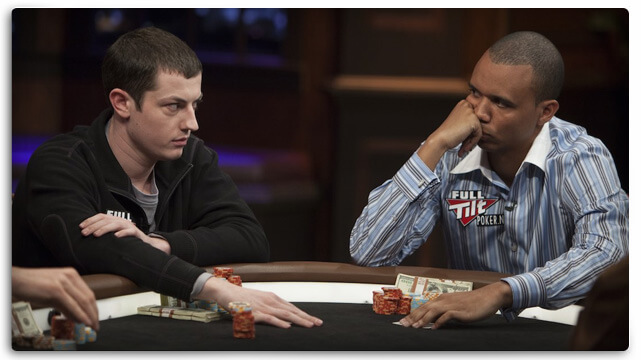I watch a lot of old movies. They’re a wonderful reflection on the times in which they were made, but they’re not reliably accurate as they tend to exaggerate and distort reality in the interests of drama and a good story.
Such is clearly the case with their depiction of poker. In the movies, poker is all about “tells” and keeping a good poker face. To win at poker in the movies, the superior player need only concentrate hard enough to spot the “giveaway” tell of his opponent, while stone-facedly not giving off any of his own.

In reality, this is rarely the case. While players may exhibit certain unconscious behaviors that may help their opponents determine whether they are strong or weak, these tells are rarely consistent nor frequent enough to give the typical player in a typical game much of an edge. If anything, looking for these tells is often an unhelpful distraction from what should be the chief task at hand – playing thoughtful poker.
In reality, determining the true strength of an opponent’s hand is often much easier than picking up on a few tells. The good player really needs to do little more than pay attention and remember what his opponent consciously does at the table. It’s the conscious actions that will give away the true strength of an opponent’s hand.
Don’t Overthink It
In a typical game, most players reveal the true strength of their hands in very simple and easy-to-spot ways. When they perceive themselves to be strong, they bet or they raise. When they think they are on a drawing hand, they tend to check and call. When they gauge themselves to be weak, they tend to fold to pressure. Most of the time, if we rely on these general patterns, we can correctly assess the true strength of our opponent’s hand.
The problem: many otherwise good players overthink the meaning of their opponent’s action. They know that people can bluff, and have even attempted bluffs themselves. So, when their opponent makes a large bet or raise, they sometimes fail to make the logical inference that their opponent is strong and, instead, think that their opponent is probably bluffing. This is, generally, a colossal error.
There’s a useful expression that should be applied regularly to poker. If you’re in the American West and hear hoof beats, they’re probably horses, not zebras.
It may be zebras, of course — some crazy millionaire may have imported dozens of zebras just for this occasion — but, most of the time, the herd will be horses.
Sizing Up Different Bluffers
That said, there are four common situations where a bet or a raise often does not indicate true strength. Let’s list them:
- A Loose-Aggressive Player (LAG) bets or raises
By definition, a LAG is someone who frequently initiates or escalates action without strong cards. When they bet or raise, it often does not indicate strength.- A late-position player raises the blinds
Players often do this without premium cards.- A pre-flop raiser initiates a bet on the flop
This is known as a “continuation bet” or “c-bet,” and has become fairly standard. It doesn’t necessarily indicate any true strength in the bettor’s hand.- A short-stacked player goes all-in
Players sometimes reach a level of misery or frustration that propels them to fire their few remaining chips, regardless of the value of their hand. They bet or raise figuring they’ll either win big or go home. These bets often have nothing to do with the true strength of their hand.
Typically, among beginning, intermediate, and non-highly skilled players, significant bets and raises mean strength. Here are some examples of what I’m talking about.
- You raised to $12 in late position with A♥ T♥. You got two callers, against whom you have position. The flop is K♥ 9♠ 6♠. Your first opponent bets $25 and the second folds. The bettor almost surely has a strong hand or very strong draw.
- You’re in early position with J♥ J♠. You raise to $12 and a couple of players call. The flop is A♠ T♦ 2♣. You bet $20 and are raised to $45. Your opponent almost surely has a strong hand.
- You’re in middle position with A♥ K♥. An early-position player raises to $10, you call, and a player behind raises to $35. The initial raiser makes it $75. At least one of your opponents surely has a very strong hand.
In each of these examples, many players are tempted to stick with their “good” hands, even when the evidence is telling them not to. They’re hearing zebras instead of horses, and don’t want to muck a strong starting hand that became weaker after the flop. Even so, we must vigilantly resist the urge to read deception into situations that would otherwise require us to fold hands that we have long waited for.
In countless more examples that you could construe, your opponent is telling you he has a very strong hand. You don’t need to see any special tell. You know it because of his conscious behavior – his bet.
While it is tempting, in the interest of continuing with the hand, to assign deceptive intent to your opponent’s actions, it will often save you a ton of money to believe what you are seeing and to fold.
Ashley Adams is the author of Winning 7-card Stud (Kensington 2002), Winning No-Limit Hold’em (Lighthouse 2011), and most recently Winning Poker in 30 Minutes a Day (D&B Publishing 2020). He also has hosted since 2007 House of Cards, the longest-running poker radio show in the world.


